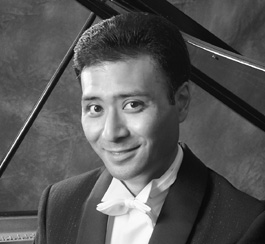home | metro santa cruz index | music & nightlife | review

Photograph by Peter Schaff
Jon Nakamatsu: KUSP-FM will broadcast Sunday's performance on Feb. 11.
Proceeding With Caution
Nakamatsu's Beethoven starts off note-perfect but all too safe at Santa Cruz Symphony performance
By Scott MacClelland
While Beethoven's First Piano Concerto doesn't really dethrone the great Mozart concertos, it does deserve more attitude than Jon Nakamatsu gave it Sunday afternoon at Watsonville's Mello Center. Nothing Mozart wrote so intimidated--or challenged--Beethoven more than the piano concertos. He is said to have remarked, after hearing Mozart's no. 24 in C Minor in 1798, "We shall never be able to do anything like that!" Two years later he did something like that, muscling up on Mozart big time with his own C Minor Concerto. Also in 1800, he revised the Concerto no. 1 in C, even though that earlier opus still sounds relatively cautious. (The development section of the first movement--the domain of Beethoven's awesome power in later works--is positively reticent.) But its rondo finale is worthy of Mozart, a brash adventure that flashes bold violations of the form and produces effects of unprecedented excitement. It was here that Nakamatsu showed his true colors, setting a brisk tempo, cavorting on the edge and bringing everything alive in the moment. Earlier on, he too was cautious, if nonetheless note-perfect and polished as one has learned to expect from that rare breed of Van Cliburn gold-medalists who have sustained high-profile careers across all the intervening years.
The Mello audience liked what they heard and brought Nakamatsu back until he encored with Schumann's song Widmung in the heroic without-voice version by Liszt (that must have inspired Richard Strauss when he composed his Zueignung, a lied of similar dedication and inflated character.) In the first movement of the Beethoven, Nakamatsu used the infrequently played, harmonically daring second (of three) solo cadenzas written by Beethoven himself some years after the concerto.
Larry Granger began his program with Rossini's overture La gazza ladra, that toe-tapping masterpiece that shows off an orchestra--as it did here--to fine effect (and provided John Philip Sousa with a template that can be heard plainly in the middle section of "Semper fidelis," and others of his marches). A slight disagreement among the violins at one point did nothing to disrupt the propulsive inevitability of the composer's conception. The attentively darting ear savored the miscellany of cameos on oboe, flute, bassoon, horn, snare drum, et. al.
The second half went to Mendelssohn's Midsummer Night's Dream music, beginning with the famous overture, which he composed at age 17, and ending with the Wedding March, its trumpets and trombones blaring. The elfin Scherzo ignored a fleeting smudge in the strings and the Nocturne warmed up nicely with its full-bodied orchestration. I wonder how many in the audience recognized Bottom's braying donkey in the overture, a masterpiece of both form and pictorialism that parades the main characters in their various guises.
This performance was recorded for broadcast on KUSP-FM (88.9), Feb. 11, 11am.
Send a letter to the editor about this story.
|
|
|
|
|
|